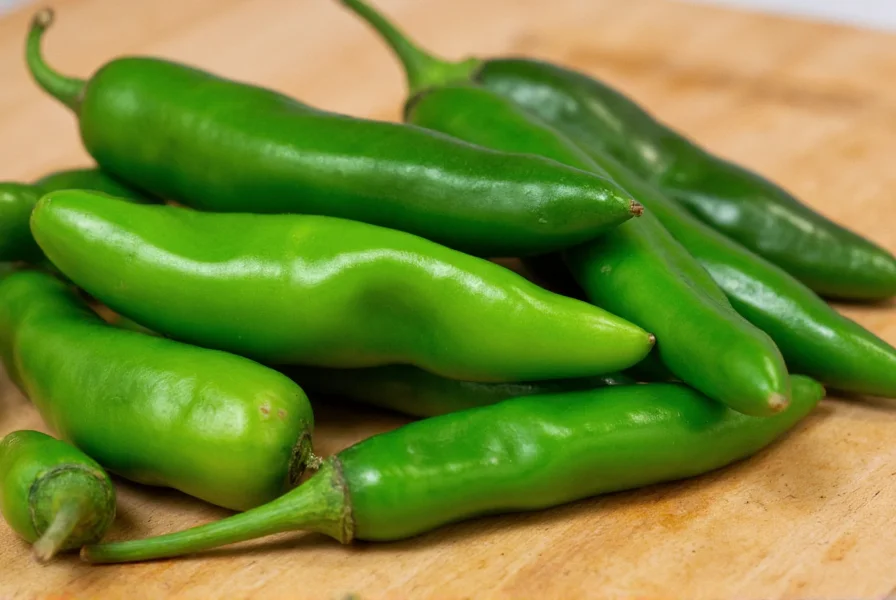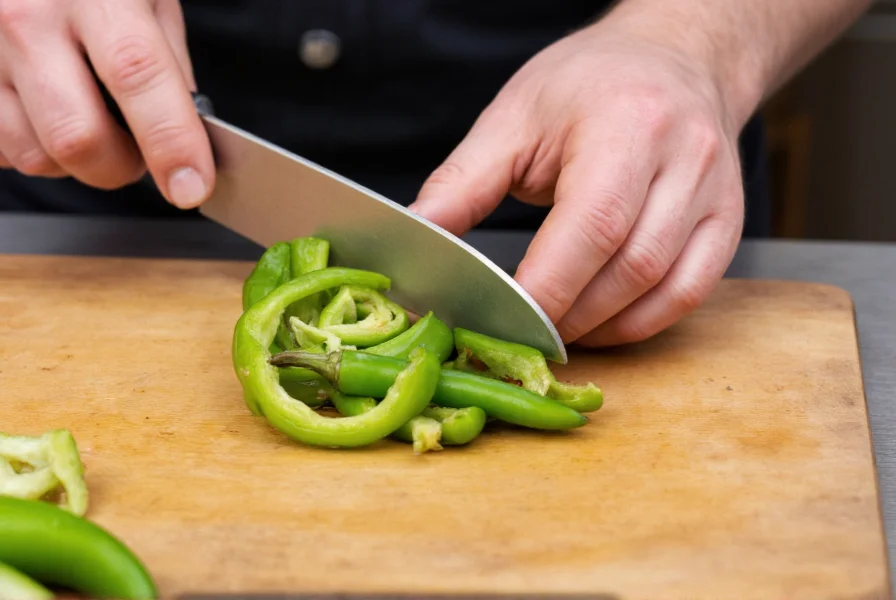Green chilies represent one of the most versatile ingredients across global culinary traditions. Unlike their mature red counterparts, these unripe peppers offer a unique flavor profile—bright, vegetal, and often more complex than fully ripened chilies. Understanding the different varieties, heat levels, and proper handling techniques unlocks their full potential in everyday cooking.
Common Green Chili Varieties and Their Characteristics
Not all green chilies are created equal. Each variety brings distinct flavor notes and heat levels to dishes:
| Chili Variety | Scoville Heat Units | Flavor Profile | Best Culinary Uses |
|---|---|---|---|
| Jalapeño | 2,500-8,000 SHU | Grassy, slightly sweet | Salsas, nachos, stuffed peppers |
| Serrano | 10,000-23,000 SHU | Sharp, bright, herbal | Pico de gallo, hot sauces, guacamole |
| Poblano | 1,000-2,000 SHU | Earthy, mild, slightly sweet | Mole sauces, chiles rellenos, roasted dishes |
| Habanero (green) | 100,000-350,000 SHU | Floral, citrusy, extremely hot | Caribbean sauces, hot marinades (use sparingly) |
Understanding Green Chili Heat Levels
The Scoville scale measures chili pepper heat, but fresh green chilies can vary significantly even within the same variety. Factors affecting heat include:
- Stress conditions: Plants grown in challenging conditions often produce hotter peppers
- Seed proximity: The white pith and seeds contain most capsaicin—the compound responsible for heat
- Ripeness stage: Even among green chilies, those closer to ripening tend to be milder
When working with fresh green chili varieties, always taste a small piece first before adding to dishes. This prevents accidentally creating an inedibly spicy meal. For consistent results in recipes, remove seeds and membranes where most heat concentrates.

Nutritional Benefits of Green Chilies
Green chilies offer impressive nutritional value beyond their flavor contribution. A single medium jalapeño (about 14g) contains:
- 75% of your daily vitamin C requirement
- Significant vitamin B6 and potassium
- Antioxidants like capsaicin and carotenoids
- Nearly zero calories (about 4 calories per pepper)
Research suggests regular consumption of health benefits of green chili peppers may support metabolism, reduce inflammation, and improve circulation. The capsaicin compound has been studied for potential pain relief properties when applied topically.
Practical Handling and Preparation Techniques
Working with hot green chilies requires proper technique to avoid discomfort:
- Wear gloves when handling extremely hot varieties like habaneros
- Avoid touching your face, especially eyes, while preparing chilies
- Use separate cutting boards for chilies to prevent cross-contamination
- Remove seeds and membranes with a small spoon for reduced heat
- Wash hands thoroughly with soap and water after handling (alcohol-based sanitizers can spread capsaicin)
If you experience skin irritation from handling hot green chilies safely, apply milk or yogurt to the affected area—capsaicin is fat-soluble, so dairy products help neutralize the burn.
Culinary Applications Across Global Cuisines
Green chilies form the backbone of flavor in numerous international dishes:
- Mexican cuisine: Roasted poblano peppers in chiles rellenos, serranos in fresh salsas
- Thai cooking: Bird's eye chilies in green curry paste and dipping sauces
- Indian dishes: Green chilies in chutneys, curries, and as tempering ingredients
- Caribbean preparations: Scotch bonnet peppers in jerk marinades and sauces
For authentic results when exploring how to use green chili in cooking, consider these techniques:
- Roast over open flame to develop smoky sweetness
- Pickle for tangy condiments that last months
- Blend raw into salsas for fresh, vibrant heat
- Freeze whole for year-round availability

Substituting Green Chilies in Recipes
When your recipe calls for a specific green chili that's unavailable, consider these substitutions:
- Jalapeño substitute: Serrano (hotter) or cubanelle (milder)
- Poblano alternative: Anaheim pepper or green bell pepper with pinch of cayenne
- Serrano replacement: Jalapeño (less hot) or Thai bird's eye chili (much hotter)
Remember that substituting green chili in recipes requires adjusting quantities based on heat differences. When in doubt, start with half the amount of a hotter substitute and taste before adding more.
Storing Green Chilies for Maximum Freshness
Proper storage extends the life of your green chilies:
- Refrigeration: Store unwashed in crisper drawer for 1-3 weeks
- Freezing: Freeze whole peppers in airtight bags for 6-12 months (no need to thaw before use)
- Pickling: Preserve in vinegar solution for 6+ months
- Drying: String and air-dry or use food dehydrator for long-term storage
Never store green chilies near ethylene-producing fruits like bananas or tomatoes, as this accelerates ripening and can increase heat levels unpredictably.
Growing Your Own Green Chilies
Home gardeners can enjoy fresh green chilies with minimal effort:
- Start seeds indoors 8-10 weeks before last frost
- Transplant outdoors when soil reaches 70°F (21°C)
- Harvest when peppers reach full size but remain green
- Pick regularly to encourage more production
Growing green chili plants at home allows you to control heat levels—water-stressed plants produce hotter peppers, while well-watered plants yield milder results. Most varieties mature in 60-90 days from transplanting.
Frequently Asked Questions
Are green chilies just unripe red chilies?
Yes, most green chilies are simply unripe versions of what will become red, yellow, or orange chilies when fully matured. The green color indicates chlorophyll presence before carotenoids develop during ripening. Some varieties like certain jalapeños are typically harvested green before they have a chance to ripen fully.
How can I reduce the heat of green chilies in a dish that's already too spicy?
To reduce excessive heat in a dish, add dairy products like yogurt or sour cream, which contain casein that binds to capsaicin. Acidic ingredients like lime juice or vinegar can also help balance heat. Adding more non-spicy ingredients to dilute the dish works well for soups and stews. Never use water, as it spreads the capsaicin rather than neutralizing it.
What's the difference between green and red chili peppers nutritionally?
Green chilies contain more chlorophyll and slightly less vitamin C than their red counterparts, but they're higher in certain antioxidants found in unripe peppers. Red chilies have developed more carotenoids (like beta-carotene) during ripening. Both provide significant nutritional benefits, with red chilies generally containing 20-30% more vitamin C due to extended time on the plant.
Can I eat green chilies if I have acid reflux?
People with acid reflux or GERD should exercise caution with green chilies, as capsaicin can relax the lower esophageal sphincter and trigger symptoms. If you're sensitive, try milder varieties like poblanos in small quantities, remove seeds completely, and pair with dairy to mitigate effects. Consult your healthcare provider for personalized advice regarding green chili heat level comparison and your specific condition.
How do I properly store fresh green chilies?
Store unwashed green chilies in the crisper drawer of your refrigerator for 1-3 weeks. For longer storage, freeze whole peppers in airtight containers for 6-12 months—they'll become soft when thawed but retain flavor for cooked dishes. Pickling in vinegar preserves both flavor and texture for 6+ months. Avoid storing near ethylene-producing fruits as this accelerates ripening and can unpredictably increase heat levels when following storing fresh green chilies properly guidelines.










 浙公网安备
33010002000092号
浙公网安备
33010002000092号 浙B2-20120091-4
浙B2-20120091-4